You can Download Samacheer Kalvi 6th Social Science Book Solutions Guide Pdf, Tamilnadu State Board help you to revise the complete Syllabus and score more marks in your examinations.
Tamilnadu Samacheer Kalvi 6th Social Science History Solutions Term 2 Chapter 3 From Chiefdoms To Empires
Samacheer Kalvi 6th Social Science From Chiefdoms To Empires Textual Evaluation
I. Choose the correct answer:
From Chiefdoms To Empires Question 1.
The Kingdom which was most powerful among the four Mahajanapadas
(a) Anga
(b) Magadha
(c) Kosala
(d) Vajji
Answer:
(b) Magadhaj
From Chiefdoms To Empires In Tamil Question 2.
Among the following who was the contemporary of Gautama Buddha?
(a) Ajatasatru
(b) Bindusara
(c) Padmanabha Nanda
(d) Brihadratha
Answer:
(a) Ajatasatru
From Chiefdoms To Empires Book Back Answers Question 3.
Which of the following are the sources of Mauryan period?
(a) Artha Sastra
(b) Indica
(c) Mudrarakshasa
(d) All
Answer:
(d) AII
Samacheer Kalvi Guru 6th Social Science Term 2 Question 4.
Chandra Gupta Maurya abdicated the thrown and went to Sravanbelgola along with Jaina Saint …………….
(a) Badrabahu
(b) Stulabahu
(c) Parswanatha
(d) Rushabhanatha
Answer:
(a) Badrabahu
Samacheerkalvi.Guru 6th Social Question 5.
was the ambassador of Seleucus Nicator.
(a) Ptolemy
(b) Kautilya
(c) Xerxes
(d) Megasthenese
Answer:
(d) Megasthenese
Question 6.
Who was the last emperor of the Mauryan Dynasty?
(a) Chandragupta Maurya
(b) Ashoka
(c) Brihadratha
(d) Bindusara
Answer:
(c) Brihadratha
II. Match the statement with the Reason / Tick the appropriate answer:
Question 1.
Statement (A) : Ashoka is considered as one of India’s greatest rulers.
Reason (R) : He ruled according to the principle of Dhamma.
(a) Both A and R are true and R is the correct explanation of A.
(b) Both A and R are true but R is not the correct explanation of A.
(c) A is true but R is false.
(d) A is false but R is true.
Answer:
(a) Both A and R are true and R is the correct explanation of A.
Question 2.
Which of the statements given below is/are correct?
Statement 1 : Chandragupta Maurya was the first ruler who unified entire India under one political unit.
Statement 2 : The Arthashastra provides information about the Mauryan administration
(a) only 1
(b) only 2
(c) both 1 and 2
(d) neither 1 nor 2
Answer:
(b) only 2
Question 3.
Consider the following statements and find out which of the following statement is/are correct.
- Chandragupta Maurya was the first king of Magadha.
- Rajagriha was the capital of Magadha.
(a) only 1
(b) only 2
(c) both and 2
(d) neither 1 nor 2
Answer:
(b) only 2
Question 4.
Arrange the following dynasties in chronological order.
(a) Nanda – Sishunaga – Haryanka – Maurya
(b) Nanda – Sishunaga -Maurya – Haryanka
(c) Haryanka – Sishunaga – Nanda – Maurya
(d) Sishunaga – Maurya – Nanda – Haryanka
Answer:
(c) Haryanka – Sishunaga – Nanda – Maurya]
Question 5.
Which of the following factors contributed to the rise of Magadhan Empire?
- Strategic location
- Thick forest supplied timber and elephant
- Control over sea
- Availability of rich deposits of iron ores
(a) 1, 2 and 3 only
(b) 3 and 4 only
(c) 1,2 and 4 only
(d) All of these
Answer:
(c) 1, 2 and 4 only
III. Fill in the blanks :
- ______ was the earliest capital of Magadha.
- Mudrarakshasa was written by______
- ______ was the son of Bindusara.
- The founder of the Maurya Empire was______
- ______ were appointed to spread Dhamma all over the empire.
Answer:
- Raj agriha
- Visakadatta
- Ashoka
- Chandragupta Maurya
- Mahamattas
IV. State True or False:
- The title Devanam Piya was given to Chandragupta Maurya.
- Ashoka gave up war after his defeat in Kalinga.
- Ashoka’s Dhamma was based on the principle of Buddhism.
- The lions on the currency notes is taken from the Rampurwa bull capital.
Answer:
- False
- False
- True
- False
V. Match the following :
a. Gana 1. Arthasastra
b. Megasthenese 2. Religious tours
c. Chanakya 3. people
d. Dharmayatras 4. Indica
(a) 3 4 1 2
(b) 2 4 3 1
(c) 3 1 2 4
(d) 2 1 4 3
Answer:
(a) 3 4 1 2
VI. Answer in one or two sentences
Question 1.
Mention any two literary
Answer:
- Secular Literature
- Religious Literature: Vedic, Jain, Buddhist texts and Puranas
Question 2.
What is a stupa?
Answer:
- A stupa is a semi-spherical dome-like structure. It is constructed on brick or stone.
- The buddha’s relics were placed in the centre.
Question 3.
Name the dynasties of Magadha.
Four dynasties ruled over Magadha Empire.
- The Haryanka dynasty
- The Shishunaga dynasty
- The Nanda dynasty
- The Maurya dynasty
Question 4.
What were the sources of revenue during Mauryan period?
Answer:
- The land was the most important source of revenue for the state. The land tax (bhaga) was 1/6 of the total produce.
- Additional revenue was taxes on forests, mines, salt and irrigation.
Question 5.
Who assisted Nagarika in the administration of towns?
Answer:
Sthanika and Gopa assisted Nagarika in the administration of towns.
Question 6.
What do you know from the Rock Edicts II and XIII of Ashoka?
Answer:
The Rock Edicts II and XIII of Ashoka refer to the names of three dynasties.
- Pandyas
- Cholas
- The Keralaputras and the Sathyaputras.
Question 7.
Which classical Tamil poetic works have the reference of Maurvans?
Answer:
Mamulahar’s poem in Agananuru gives the reference of the Mauryans.
VII. Answer the following :
Question 1.
What did Ashoka do to spread Buddhism?
Answer:
- Ashoka sent his son Mahinda and daughter Sanghamitta to Srilanka to propagate Buddhism.
- He also sent missionaries to West Asia, Egypt, and Eastern Europe to spread the message of Dhamma.
- The Dhamma-mahamattas were a new cadre of officials created by Ashoka.
- Their job was to spread dhamma all over the empire.
- Ashoka held the third Buddhist counil at his capital pataliputra.
Question 2.
Write any three causes for the rise of Magadha.
Answer:
- Magadha was located on the lower part of the Gangetic plain. The plain was fertile which ensured the rich agricultural yield. This provided income to the state.
- The thick forests supplied timber for construction of buildings and elephants for army.
- Abundance of natural resources especially iron enabled them to equip themselves with weapens made of iron.
VIII. HOTS:
Question 1.
Kalinga war became a turning paint in Ashoka’$ life. How?
- In the war of Kalinga, many people died.
- He understood that war only brings destruction of families.
- The Kalinga war had incredible influence over the personal life and policy of Ashoka.
- Hence Kalinga war proved to be a turning point in the life of Ashoka.
- He found his consolation in Buddhism.
- He was representing for his deeds. He embraced Buddhism and took the vow of \ inculcation ‘Dhamma’ to all men through out his life.
- He gave up the policy of Dig Vijay and adopted the policy of Dharma Vijay.
Question 2.
Write any five welfare measures you would do if you were a king like Ashoka.
Answer:
- Free education to all.
- Free food for the disabled, the aged, the sick and the needy.
- Free medical treatment to all the citizens.
- Free shelter for the homeless.
- Justice for all. Equality of gender, religion, caste.
IX. Picture Study
Question 1.
This is the picture off an Ashokan edict.
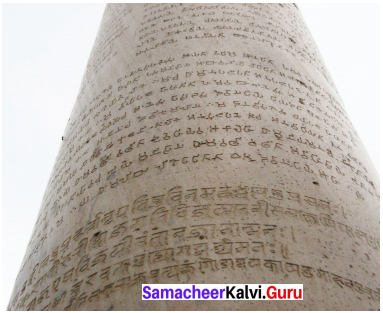
a. What are edicts?
b. How are Ashokan edicts useful?
c. Where were these edicts inscribed?
d. Name the script used in Sanchi Inscription.
e. How many Rock Edicts are there?
Answer:
(a) An Edict is an official order or proclamation issued by a person in authority or a king.
(b) Edicts are very informative about Ashoka’s belief in peace, righteousness, Justice and his concern for the welfare of the people.
(c) The edicts were inscribed on the pillars as well as boulders and cave walls made by the Emperor Ashoka.
(d) Brahmi Script.
(e) 33 Rock Edicts.
X. Who am I
- I belonged to Haryanka dynasty. I extended territory by matrimonial alliances. My son is Ajatasatru – who am I?
- I played a significant role in the transformation of society. I am used in making ploughshare – Who am I?
- I was known as Devanampiya. I embraced the path of peace – Who am I?
- I established the first largest empire in India. I performed Sallekhana. Who am I?
- Iam found in the Lion capital of Ashoka. I am at the centre of our national flag. Who am I?
Answer:
- Bimbisara
- Iron
- Ashoka
- Chandra Gupta Maurya
- Ashoka Chakra
XI. Decipher the code – The Mauryan Empire.

- The first dynasty that ruled over Magadha was ______ (8, 1, 18, 25, 1, 14, 11, 1).
- ______ empire was the first largest empire (13, 1, 21,18, 25, 1).
- ______ laid the foundation of the new capital at Pataliputra. (21, 4, 1,25, 9,14).
- ______ was one of the main exports (19, 16, 9, 3, 5, 19).
- ______ became later the most renowned seat of learning. (14, 1, 12, 1, 14, 4, 1).
- Revenue from agricultural produce was called ______ (2, 8, 1, 7, 1).
- The horror of war was described in ______ (18, 15, 3, 11, 5, 4, 9, 3, 20)
- Greeks called Bindusara as ______ (1, 13, 9, 20, 18, 1,7, 1, 20, 8, 1)
- The crowning element in Saranath Pillar is ______ (4, 8,1, 18,13,1, 3, 8,1,11,18,1)
- Council of ministers were known as ______ (13, 1, 14, 4, 18, 9, 16, 1, 18, 9, 19, 8, 1,4)
Answer:
- HARYANKA
- MAURY
- UDAYIN
- SPICKS
- NALAINDA
- HAGA
- ROCK EDICT
- AMITRAG AT HA
- DHARMA CHAKRA
- MANDRIPARISHAD
XIII Map Work
- Mark the extent of Aihokan Empire.
- Mark the fallowing places a the river map of India
a. Taxila
b. Pataliputra
c. Ujjain
d. Sanchi
e. Indraprastha
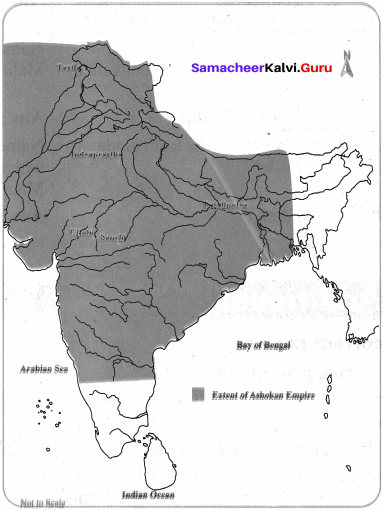
XIV Life Skill
Question 1.
Make a model of Ashoka Chakra.
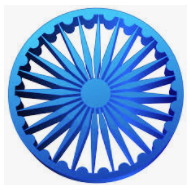
Question 2.
Make a model of Sanchi Stupa.
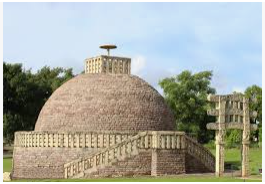
Question 3.
Draw and colour our National Flag
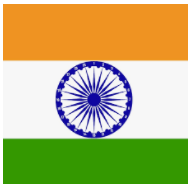
XV. Answer Grid:
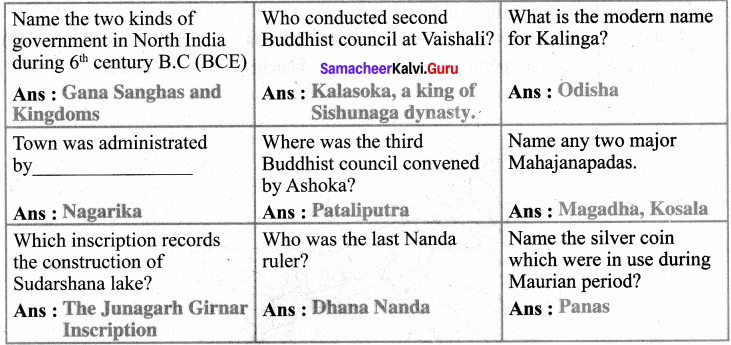
Samacheer Kalvi 6th Social Science From Chief Doms To Empires Additional Questions
I. Choose the correct answer:
Question 1.
The earliest gathering places of men were
(a) Kingdoms
(b) Janapadas
(c) Mahajanapadas
(d) Republics
Answer:
(b) Janapadas
Question 2.
The capital city Pataliputra had ……………. gates to the city.
(a) 24
(b) 32
(c) 49
(d) 64
Answer:
(d) 64
Question 3.
Udavin belonged to dynasty.
(a) Nanda
(b) Shishunaga
(c) Haryanka
(d) Maurya
Answer:
(c) Haryanka
Question 4.
Kalasoka belonged to ……………. dynasty.
(a) Haryanka
(b) Shishunaga
(c) Nanda
(d) Maurya
Answer:
(b) Shishunaga
Question 5.
The name Vishnu Gupta refers to
(a) Ajata satru
(b) Ashoka
(c) Dhana nanda
(d) Chanakya
Answer:
(d) Chanakya
Question 6.
Simhasena refers to
(a) Chandragupta
(b) Bambisara
(c) Udayin
(d) Bindusara
Answer:
(a) Chandragupta
Question 7.
Ashoka sent his son and daughter to
(a) China
(b) Burma
(c) Srilanka
(d) Indonesia
Answer:
(c) Srilanka
Question 8.
Under the Mauryas, the king was
(a) Sovereign authority
(b) head of the Judiciary
(c) Commander of the Army
(d) All the three
Answer:
(d) All the three
Question 9.
The terms Sthanika and Gopa are related to Mauryan
(a) Council
(b) Assembly
(c) Army
(d) Town Administration
Answer:
(a) Council
Question 10.
Mashakas were made out of
(a) copper
(b) gold
(c) silver
(d) paper
Answer:
(a) copper
Question 11.
Dasharatha Maurya was the grand son of
(a) Bindusara
(b) Bimbisara
(c) Dhana Nanda
(d) Ashoka
Answer:
(d) Ashoka
II. Match the statement with the Reason. Tick the appropriate answer:
Question 1.
Statement (A) : Magadha’s gradual rise to political supremacy began with Bimbisara of Haryanka dynasty.
Reason (R) : Bimbisara extended the territory of Magadhan Empire by matrimonial alliances
(a) Both A and R are true but R is not the correct explanation of A.
(b) A is true but R is false.
(c) Both A and R are true and R is the correct explanation of A.
(d) A is false but R is true.
Answer:
(c) Both A and R are true and R is the correct explanation of A.
Question 2.
Which of the statement given below is / are correct?
Statement I : Megasthenese was an Ambassador from Greece in the court of Chandragupta Maurya.
Statement II : Megasthenese – work ‘Indica’ is one of the main sources of the Mauryan Empire.
(a) Only II
(b) Only I
(c) Neither I nor II
(d) Both I and II
Answer:
(d) Both I and II
Question 3.
Consider the following statements and find out which of the following statements is/ are correct.
- Trade flourished under the Maurvans.
- Spices and Ivory works formed the main exports under the Mauryans
(a) only 1
(b) only 2
(c) Both 1 and 2
(d) Neither 1 nor 2
Answer:
(c) Both 1 and 2
Question 4.
Arrange the following rulers in Chronological order
(a) Bimbisara, Kalasoka, Mahapadma Nanda, Chandra Gupta
(b) Chandra Gupta, Mahapadma Nanda, Bimbisara, Kalasoka
(c) Kalasoka, Bimbisara, Chandra Gupta, Mahapadma Nanda
(d) Mahapadma Nanda, Chandra Gupta, Kalasoka, Bimbisara
Answer:
(a) Bimbisara, Kalasoka, Mahapadma Nanda, Chandra Gupta
Question 5.
Which of the following factors contributed to the decline of the Mauryan Empire?
- Weak successors
- Continuous revolts
- Invasion by Bactrian Greeks
- Regular and substantial income to the state.
(a) 3 and 4 only
(b) All of these
(c) 1,2 and 3 only
(d) 1,2 and 4 only.
Answer:
(c) 1,2 and 3 only
III. Fill in the blanks:
- The term ‘gana’ means ______.
- Sixteen dooted the indo – Gangetic plain in the sixth century BC
- The thick forests supplied _______ for the construction of buildings
- Kalasoka belonged to ______dynasty
- Mahapadma Nanda was succeeded by his eight sons known as_______
- The tearm nalanda means_______
- Megasthanese stayed in India for _________ Years.
- The teacher and advisor to Emperor Chandra Gupta Maurya was ______
- Chandragupta performed ________ in Sravanbelgola.
- Chandragupta Maurya’s son was ______
- Bindusara was succeeded by his son ______
- Ashoka was known as ‘Devanam Piya’ which means ______
- Ashoka’s Dhamma contained the essence of ________
- The third Buddhist council was held at ______
- The first Buddhist council was held at ______
- The second Buddhist council was held at ______
- The foundation for the new capital at Pataliputra was laid by _____
- The highest court of appeal under the Mauryans was _______
- Status of Yakshas and Yakshis belonged to the _______
- Three caves in Barabar hills have dedicative inscriprion of __________
Answer:
- people of equal status
- Mahajanapadas
- timber
- Sishunaga
- Navanandas
- No stopping of the gift of knowledge
- 14
- Chanakya / Vishnugupta/ Kautilyal
- Sallekhanai
- Bindusaral
- Ashokal
- beloved of the Gods
- All religions
- Pataliputraj
- Raj agriha
- Vaishali
- Udayin
- The king
- Indigenous
- Ashoka
IV. State True or False:
- Mahavira and Buddha represented the new awakening in the sixth century BC (BCE)
- Among the four Mahajana padas Vatsa emerged as an empire.
- Haryanka dynasty was succeeded by Sishunaga dynasty.
- Seleucus wrote the book Indica.
- Chanakya is called the Architect of the Mauryan Empire.
- After the battle of Kalinga, Ashoka became a Buddhist.
- Ashoka emphasised on obedience and respect for parents, preceptors and elders.
- Council of Ministers referred to Mantriparishad.
- Mauryans were not aware of spy system.
- Under the Mauryan administration punishments were very mild.
Answer:
- True
- False
- False
- False
- True
- True
- True
- True
- False
- False
V. Match the following:
- Panchala (a) Foreign Notice
- Mahavamsa (b) Daughter
- Ashoka (c) Proclamation
- Sangamithra (d) Mahajanapada
- Edict (e) Governor of Ujjain
Answer:
- (d)
- (a)
- (e)
- (c)
VI. Answer in one or two sentences :
Question 1.
Explain the term kingdom.
Answer:
- Kingdom means a territory ruled by a king or queen.
- In a kingdom (monarchy), a family, which rules for a long period becomes a dynasty.
- Usually these kingdoms adhered to orthodox Vedic traditions.
Question 2.
Who was Bhadrabahu?
Answer:
- Bhadrabahu was a Jain monk.
- He took Chandragupta Maurya to South India.
Question 3.
Name the sixteen Mahajanapadas.
Answer:
Name of the Sixteen Mahajanapadas are
Anga, Magadha, Vajji, Malla, Kasi, Kura, Kosala, Avanti, Chedi, Vatsa, Panchala, Machcha, Surasena, Assaka, Gandhara and Kamboja.
Question 4.
Write a note on Megasthenese.
Answer:
- Megasthenese was the ambassador of the Greek ruler, Seleucus.
- He lived in the court of ChandraGupta Maurya.
- He stayed in India for 14 years.
- He wrote the book Indica, one of the main sources for the study of Mauryan Empire.
Question 5.
Write about Pataliputra.
Answer:
- Pataliputra was the capital of the Mauryan Empire.
- It has 64 gates to the city with 570 watch towers.
Question 6.
Why is Chanakya known as the architect of the Mauryan empire?
Answer:
- Chanakya was the teacher and advisor to Emperor Chandragupta Mauryan.
- His treatise on statecraft ‘Arthashastra’ was a very great guide for rulers.
- Hence he is referred to as the architect of the Mauryan empire.
Question 7.
Explain Ashoka’s Dhamma.
Answer:
- The meaning of Dhamma is explained in Ashoka’s – Pillar Edict II.
- It contained the noblest ideas of humanism, forming the essence of all religions.
- He laid stress On Compassion, Charity, Purity, Saintliness, Self-control, Truthfulness, Obedience and respect for parents, preceptors and elders.
Question 8.
Mention the different wings of the Mauryan army.
Answer:
- Under the Mauryan army, a board of 30 members divided into six committees with five members on each, monitored
- Navy, Armoury (transport and supply), Infantry, Cavalry, The war chariots and The war elephants.
Question 9.
Mention the regions which produced specialised textiles under the Mauryas.
Answer:
The regions which produced specialised textiles under the Mauryas were Kasi (Benares), Vanga (Bengal), Kamarupa (Assam) and Madurai in Tamilnadu.
Question 10.
What were the exports and imports of the Mauryans?
Answer:
- Main exports were Spices, Pearls, Diamonds, Cotton textiles, Ivory Works, Conch Shells.
- Main Imports were Horses, Gold, Glassware, Linen.
Question 11.
Mention the two divisions of the Mauryan art.
Answer:
Mauryan art can be divided into two.
- Indigenous Art – Statues of Yakshas and Yakshis.
- Royal Art – Palaces and Public buildings, Monolithic Pillars, Rock cut Architecture, ‘ Stupas.
Question 12.
Who were Yakshas and Yakshis?
Answer:
- Yakshas were deities connected with water, fertility, trees, the forest and wilderness,
- Yakshis were their female counterpart.
VII. Answer the following:
Question 1.
Mention the role of iron in changing a society.
Answer:
- Iron played a significant role in this transformation of society.
- The fertile soil of the Gangetic Valley and the use of iron ploughshares improved , agricultural productivity.
- Iron facilitated craft production.
- Agrarian surplus and increase in craft products resulted in the emergence of trading and exchange centres.
- There were rise of towns and cities.
Question 2.
Write about the revenue system of the Mauryans.
- The land was the most important source of revenue for the state.
- Bali and Bagha as taxes collected from people.
- The land tax (bhaga) collected was 1/6 of the total produce.
- Revenue from taxes on forests, mines, salt and irrigation provided additional revenue to the government.
- Much of the State revenue was spent on paying the army, the officials of the royal government, on charities and on different public works.
Question 3.
Mention the reasons for the decline of the Mauryan empire.
Answer:
- Ashoka’s successors were very weak.
- Continuous revolts in different parts of the empire.
- Invasion by the Bactrian Greeks weakened the empire.
- Pacifist policy of Ashoka weakened the military strength.
- Last Maurya ruler Brihadratha was killed by his commander Pushyamitra Sungha.
VIII. HOTS:
Question 1.
State the salient feature of the Lion Capital of Ashoka.
Answer:
- The lion capital of Ashoka is a sculpture of four Asiatic lions standing back to back on an elaborate base.
- This base includes other animals.
- A graphic representation of it was adopted as the official emblem of India in 1950.
- It was originally placed atop the Ashoka pillar at the important Buddhist site of Samath by the Emperor Ashoka, in about 250 BCE.
- The pillar, sometimes called the Ashoka Column, is still in its original location.
- But the Lion Capital is now in the Samath Museum, in the state of Uttar Pradesh.
- It is 7 feet high including the base.
- The Ashoka Chakra is a depiction on the Buddhist Dharma Chakra with 24 spokes.
Question 2.
One of the seven wonders of Ancient world – Great wall of China – Prove.
Answer:
- The Great Wall of China is a series of fortifications made of stone, brick, tamped earth, wood, and other materials.
- It is built along an east-to-west line across the historical northern borders of China.
- It was built to protect the Chinese states and empires against the raids and invasions of the various nomadic groups of the Eurasian Steppe.
- It was built by Qin Shi Huang, the first Emperor of China. Little of that wall remains.
- The Great Wall has been rebuilt, maintained, and enhanced over various dynasties.
Question 3.
The temple of Zeus at Olympia is an important piece of art in Greek history. – Do you agree?
Answer:
- The temple of Zeus at Olympia was an ancient Greek temple in Olympia, Greece.
- It was dedicated to the God Zeus.
- The temple was built in the second quarter of the 5th Century BCE.
- Zeus is the Sky and Thunder God in ancient Greek religion, who rules as king of the Gods of Mount Olympus.
Question 4.
What do you about the Lomas Rishi cave, Barabar.
Answer:
- The Lomas Rishi Cave, also called the Grotto of Lomas Rishi, is one of the man¬’ made Barabar Caves in the Barabar and Nagarjuni hills of Jehanabad district in Bihar.
- This rock-cut cave was carved out as a sanctuary.
- It was built during the Ashokan period of the Maurya Empire in the 3rd century BC.
Question 5.
Nalanda served as a great source of knowledge. Prove.
Answer:
- Nalanda was a large Buddhist monastery, in the ancient kingdom of Magadha (modern-day Bihar) in India.
- It is a UNESCO World Heritage Site.
- Nalanda flourished under the patronage of the Gupta Empire in the 5th and 6th centuries.
- The word Nalanda is a Sanskrit combination of three words Na + alam + daa meaning “no stopping of the gift of knowledge”.
- The school attracted scholars and students from near and far with some travelling from Tibet, China, Korea and Central Asia
Question 6.
State the importance of Girnar Inscription of Rudradaman.
Answer:
- The Junagarh / Gimar Inscription gives the information about the Sudarshana Lake
- This lake was an artificial reservoir.
- The Construction was begun during the time of Chandra Gupta Maurya and completed during Ashoka’s reign.
- It was built by the Mauryan kings to check floods.
- Around 150AD, lake was repaired by the Shaka ruler Rudradaman I.
- Again it was repaired under the Skandagupta’s reign by his Governor Pamadatta.
IX. Who am I
- I Practise egalitarian traditions.
- I supply elephants for army.
- I was overthrown by Chandra Gupta Maurya.
- I wrote a treatise on state craft.
- I was called by the Greeks as ‘slayer of enemies’.
- I carry an official order or proclamation issued by a king.
- I am the crowning element of Saranath Pillar.
- I am known as Patna now. Originally who was I?
Answer:
- Gana-Sangha
- Thick forests
- Dhana Nanda
- Chanakya
- Bindusara
- Edict
- Dharmachakra
- Pataliputra
X. Decipher the code – The Mauryan. Empire.

- It means a territory ruled by a king or queen ______ (11, 9, 14, 7, 4, 15, 13).
- He shifted the Capital from Rajagirha to Pataliputra. (11, 1, 12,1, 19, 15, 11, 1).
- One of the religions sources of the Mauryan Empire ______ (16,21,18,1,14,1, 19).
- It is a part of our National Flag. (1, 19, 18,15, 11, 1,3,8, 1, 11, 19, 1).
- Construction of this lake was begun during the time of Chandra Gupta Mauryan and completed during Ashoka’s reign ______ (19, 21, 4, 1, 18, 19, 8, 1, 14, 1).
- One of the main exports of the Mauryan Period. (4, 9, 1, 13, 15, 14, 4, 19).
- Statues of Yakshas and Yakshi come under the ______ art of the Mauryans,(9, 14, 4, 9, 7, 5, 14, 15, 14,21, 19)
- Ancient name of Odisha. (11, 1, 12, 9, 14, 7, 1).
Answers:
- KINGDOM
- KALASOK
- PURANAS
- ASHOKA CHAKRA
- SUDARSH ANA
- DIAMONDS
- INDIGENOUS
- KALLNGA